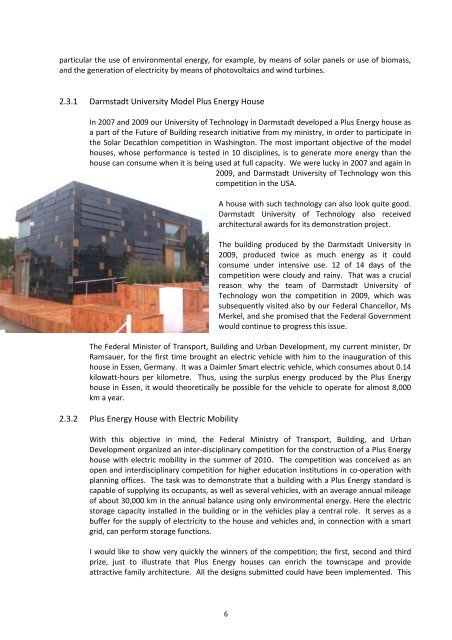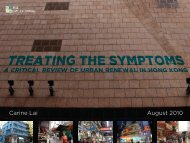Download summary report - Civic Exchange
Download summary report - Civic Exchange
Download summary report - Civic Exchange
Create successful ePaper yourself
Turn your PDF publications into a flip-book with our unique Google optimized e-Paper software.
particular the use of environmental energy, for example, by means of solar panels or use of biomass,<br />
and the generation of electricity by means of photovoltaics and wind turbines.<br />
2.3.1 Darmstadt University Model Plus Energy House<br />
In 2007 and 2009 our University of Technology in Darmstadt developed a Plus Energy house as<br />
a part of the Future of Building research initiative from my ministry, in order to participate in<br />
the Solar Decathlon competition in Washington. The most important objective of the model<br />
houses, whose performance is tested in 10 disciplines, is to generate more energy than the<br />
house can consume when it is being used at full capacity. We were lucky in 2007 and again in<br />
2009, and Darmstadt University of Technology won this<br />
competition in the USA.<br />
A house with such technology can also look quite good.<br />
Darmstadt University of Technology also received<br />
architectural awards for its demonstration project.<br />
The building produced by the Darmstadt University in<br />
2009, produced twice as much energy as it could<br />
consume under intensive use. 12 of 14 days of the<br />
competition were cloudy and rainy. That was a crucial<br />
reason why the team of Darmstadt University of<br />
Technology won the competition in 2009, which was<br />
subsequently visited also by our Federal Chancellor, Ms<br />
Merkel, and she promised that the Federal Government<br />
would continue to progress this issue.<br />
The Federal Minister of Transport, Building and Urban Development, my current minister, Dr<br />
Ramsauer, for the first time brought an electric vehicle with him to the inauguration of this<br />
house in Essen, Germany. It was a Daimler Smart electric vehicle, which consumes about 0.14<br />
kilowatt-hours per kilometre. Thus, using the surplus energy produced by the Plus Energy<br />
house in Essen, it would theoretically be possible for the vehicle to operate for almost 8,000<br />
km a year.<br />
2.3.2 Plus Energy House with Electric Mobility<br />
With this objective in mind, the Federal Ministry of Transport, Building, and Urban<br />
Development organized an inter-disciplinary competition for the construction of a Plus Energy<br />
house with electric mobility in the summer of 2010. The competition was conceived as an<br />
open and interdisciplinary competition for higher education institutions in co-operation with<br />
planning offices. The task was to demonstrate that a building with a Plus Energy standard is<br />
capable of supplying its occupants, as well as several vehicles, with an average annual mileage<br />
of about 30,000 km in the annual balance using only environmental energy. Here the electric<br />
storage capacity installed in the building or in the vehicles play a central role. It serves as a<br />
buffer for the supply of electricity to the house and vehicles and, in connection with a smart<br />
grid, can perform storage functions.<br />
I would like to show very quickly the winners of the competition; the first, second and third<br />
prize, just to illustrate that Plus Energy houses can enrich the townscape and provide<br />
attractive family architecture. All the designs submitted could have been implemented. This<br />
6

















